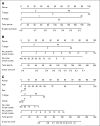Predicting survival after curative colectomy for cancer: individualizing colon cancer staging
- PMID: 22084366
- PMCID: PMC3664036
- DOI: 10.1200/JCO.2011.36.5080
Predicting survival after curative colectomy for cancer: individualizing colon cancer staging
Abstract
Purpose: Cancer staging determines extent of disease, facilitating prognostication and treatment decision making. The American Joint Committee on Cancer (AJCC) TNM classification system is the most commonly used staging algorithm for colon cancer, categorizing patients on the basis of only these three variables (tumor, node, and metastasis). The purpose of this study was to extend the seventh edition of the AJCC staging system for colon cancer to incorporate additional information available from tumor registries, thereby improving prognostic accuracy.
Methods: Records from 128,853 patients with primary colon cancer reported to the Surveillance, Epidemiology and End Results Program from 1994 to 2005 were used to construct and validate three survival models for patients with primary curative-intent surgery. Independent training/test data sets were used to develop and test alternative models. The seventh edition TNM staging system was compared with models supplementing TNM staging with additional demographic and tumor variables available from the registry by calculating a concordance index, performing calibration, and identifying the area under receiver operating characteristic (ROC) curves.
Results: Inclusion of additional registry covariates improved prognostic estimates. The concordance index rose from 0.60 (95% CI, 0.59 to 0.61) for the AJCC model, with T- and N-stage variables, to 0.68 (95% CI, 0.67 to 0.68) for the model including tumor grade, number of collected metastatic lymph nodes, age, and sex. ROC curves for the extended model had higher sensitivity, at all values of specificity, than the TNM system; calibration curves indicated no deviation from the reference line.
Conclusion: Prognostic models incorporating readily available data elements outperform the current AJCC system. These models can assist in personalizing treatment and follow-up for patients with colon cancer.
Conflict of interest statement
Authors' disclosures of potential conflicts of interest and author contributions are found at the end of this article.
Figures




References
-
- American Joint Committee on Cancer. AJCC Request for Proposals Online, October 3, 2005. http://www.cancerstaging.org/initiatives/rfp.html.
-
- National Cancer Institute, Surveillance, Epidemiology, and End Results. Localized/regional/distant stage adjustments. http://www.seer.cancer.gov/seerstat/variables/seer/yr1973_2005/lrd_stage.
-
- Cox DR. Regression models and life tables. J R Stat Soc B. 1972;34:187–220.
-
- Cox DR. Partial likelihood. Biometrika. 1975;62:269–276.
-
- Kattan MW, Eastham JA, Stapleton AM, et al. A preoperative nomogram for disease recurrence following radical prostatectomy for prostate cancer. J Natl Cancer Inst. 1998;90:766–771. - PubMed
Publication types
MeSH terms
LinkOut - more resources
Full Text Sources

